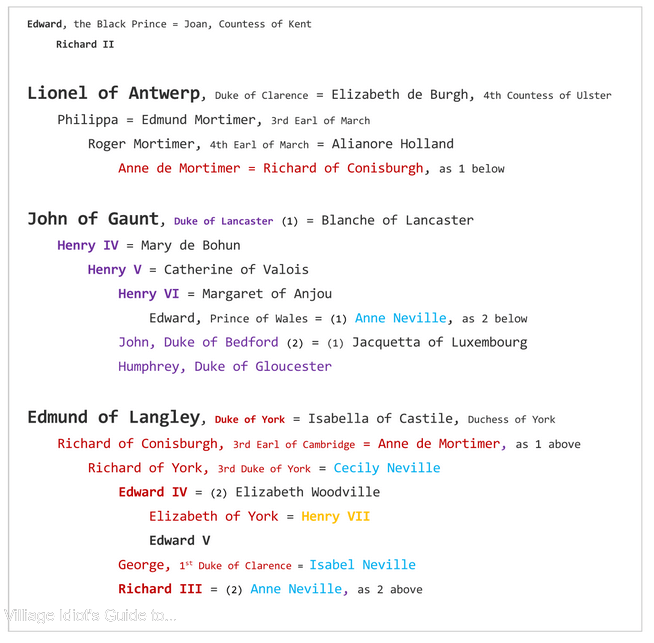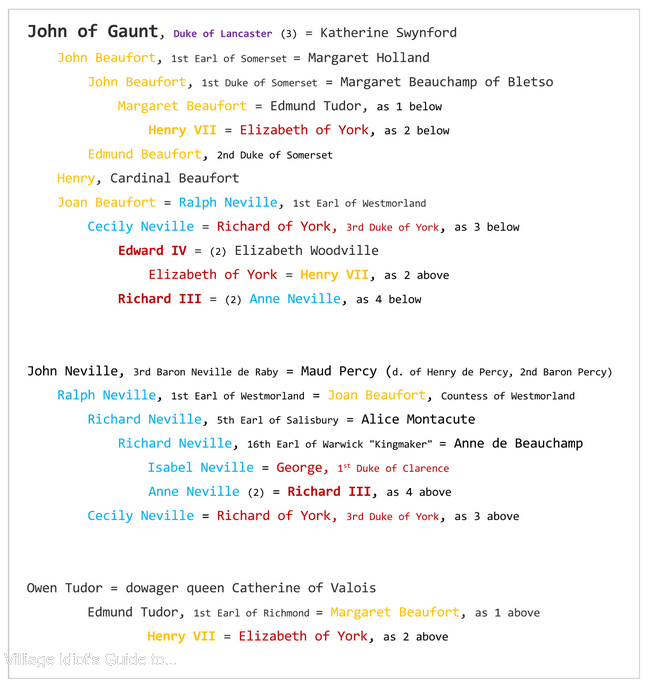Table of Contents
Wars of the Roses: Background
The Wars of the Roses were a series of battles fought between the supporters of the House of Lancaster (Lancastrians - red rose) and the supporters of the House of York (Yorkists - white rose).
Both houses were direct descendents of king Edward III, with causes of the wars dating back to power struggles between Edward's sons after his death in 1377:

Lancaster...
Henry VI was not a strong king like his father, Henry V. At only four months old when his father died, it was his father’s brothers who ruled England and France in his place. In adulthood he was dominated by his ambitious wife, Margaret of Anjou, and prone to bouts of insanity… [work in progress]
York...
Richard of York, 3rd Duke of York, was appointed Regent and commander of the English forces in France in 1436, taking the place of the king's recently deceased uncle John of Lancaster, 1st Duke of Bedford. The main objective was to retain land in France until Henry VI reached majority to rule in his own name. Richard settled his troops in Normandy. He returned to England in November 1437. When peace negotiations failed in 1440, Richard was again sent to France, this time as Lieutenant.
... and enter the Beaufort line
In 1443, John Beaufort, 1st Duke of Somerset, was given command of a large number of troups, disrupting Richard's resources. Somerset's appointment, however, achieved nothing, and he died on 1444.
Richard returned to England again in 1445, more than likely expecting his services in France to continue, yet the lieutenancy was given to John Beaufort's brother, Edmund, 2nd Duke of Somerset.
1447 saw the mysterious death of the king's uncle (and heir presumptive) Humphrey, Duke of Gloucester, and Richard became a possible successor to the English throne should Henry VI die childless - this year also brought Richard a ten year appointment as Lieutenant of Ireland: an office in exile?
By 1449, the English failures in France were mounting up. Edmund Beaufort surrendered Rouen, leading directly to the fall of Normandy to the French king, Charles VII. Despite becoming unpopular, as a favourite and cousin of King Henry VI, Edmund retained his position in court. Further disaster followed in 1451 with the loss of Bordeaux, and the English were finally driven from France by the defeat at the battle of Castillon in Gascony, 1453.
King Henry suffered a breakdown and, although the king's councel continued working, with the death of the Chancellor, Cardinal John Kemp, in March 1454, this was no longer constitutional. Despite being opposed by the king's wife, Margaret of Anjou, Richard was named regent as Protector of the Realm five days later. Richard appointed his brother-in-law, Richard Neville, 5th Earl of Salisbury, as Chancellor, and had Edmund Beaufort imprisoned in the Tower of London.
“If Henry's insanity was a tragedy, his recovery was a national disaster.”
- R.L. Storey, historian.
Chronology of the Wars of the Roses
King Henry VI, Somerset, Northumberland and Clifford - Lancastrians
Duke of York, Warwick, Salisbury - Yorkists
1450 spring & summer: Jack Cade's Revolt.
1450 August: Return of Richard, Duke of York from Ireland.
1451 spring: John and William Merfold's Uprising.
1453 December: Henry VI first bout with mental illness.
1454 April: Start of York's first protectorate.
1455 February: End of York's first protectorate.
1455 22 May: First Battle of St Albans. Yorkist victory. Duke of Somerset is killed. Duke of York re-appointed Protector.
1456: End of York's second protectorate.
1459 23 September: Battle of Blore Heath. Yorkist victory.
1459 12 October: Battle of Ludford Bridge. Lancastrian victory. Richard of York flees to Ireland.
10 July 1460: Battle of Northampton. A Yorkist victory; King Henry VI captured. Massacre of prisoners ordered by the Earl of Warwick. The Queen fled to Wales.
10 October 1460. The return of Richard of York who was declared heir to the throne. In response, the Queen raised a new army.
1460 25 October: Parliament enacts The Act of Accord
30 December 1460. Battle of Wakefield. The Yorkists were defeated and Richard, Duke of York, was killed. He was succeeded by his son Edward.
2 February 1461: Battle of Mortimer Cross. Richard of York’s son Edward, Earl of March was victorious.
17 February 1461: Second Battle of St Albans. A victory for the House of Lancaster. Henry VI rescued.
4 March 1461. Edward of York, Edward IV, proclaimed king in London.
9 March 1461. Battle of Towton. Another Yorkist victory for The Earl of Warwick. Flight of King Henry, Queen Margaret and the Prince of Wales to Scotland.
24 June 1465: Henry VI captured and imprisoned in the Tower of London.
1 May 1470. After quarrelling with Edward IV, Warwick the Kingmaker fled to France There he joined forces with Queen Margaret before returning to England and restoring the Lancastrian Henry VI to the throne on 13th October.
14 March 1471. The Yorkist King Edward fled to France, returning with a small army.
14 April 1471. Battle of Barnet. A victory for Edward’s Yorkist army. Warwick the Kingmaker killed.
4 May 1471. Battle of Tewkesbury. A defeat for the Lancastrian army, led by Queen Margaret and the Prince of Wales. The Prince of Wales was killed and the queen was captured.
21- 22 May 1471. Henry VI was killed in the Tower of London. Henry Tudor, the Earl of Richmond and Lancastrian claimant to the throne, fled to France.
The Yorkist Edward IV was now the undisputed king.
9 April 1483. Death of Edward IV, succeeded by his young son Edward V.
June 1483. Edward V and his brother declared illegitimate by Parliament. Richard Duke of Gloucester, brother of Edward IV, asked to take the throne as Richard III
Probably summer of 1483. Murder of Edward V and his brother in the Tower of London.
7 August 1485. Henry Tudor, last of the Lancastrians, landed at Milford Haven in Wales.
22 August 1485. Battle of Bosworth. King Richard III killed and the Lancastrian Henry Tudor became King Henry VII.
Henry married Elizabeth of York thus uniting the two houses, and founded the Tudor dynasty. The Tudor Rose includes both red and white roses to symbolise the uniting of the Houses of York and Lancaster.
In italics: using as a starting outline - from: The Wars of the Roses by Ben Johnson

